Kia shuns CVTs in favour of DCTs
The world's fastest-growing automotive manufacturer is staying clear of continuously variable transmissions (CVT).
Speaking with CarAdvice at the 2012 Paris Motor Show, Kia's European head of powertrain development, Joachim Hahn, confirmed the company has no plans to introduce a CVT in the future.
"So far, from the drivability [perspective] we are quite happy with the solution we have, so we are not planning to have a CVT," Hahn said.
Like its sister company Hyundai, Kia produces some of its own transmissions in-house. So far the Koreans have stuck to mass-producing their six-speed automatic, which sees use in everything from the Kia Rio to the Kia Sorento.
Unlike the Japanese manufacturers, which have nearly all gone down the path of CVTs to replace conventional automatics in the pursuit of improved fuel consumption and reduced emissions, the Koreans are more inclined to follow the Germans and introduce even more dual-clutch transmissions (DCT) in the future. The first brand's vehicle with a DCT is the Kia Cee'd.
Kia plans to step up its expansion of DCTs with development work underway to create a stronger gearbox for more powerful engine applications.
“Our wish is to have a DCT to be combined with turbocharged gasoline and diesel engines and demand for that is to have in the end a DCT which is able to transform 350Nm [of torque], which the current application is not able to do,” Hahn said.
The 350Nm torque limit will still put future Korean DCTs outside of reach for the R-series diesel engine in the Kia Sportage (392Nm) and Sorento (436Nm), but opens up new opportunities for turbocharged petrol and other diesel variants. It also means that a Hyundai Veloster Turbo with a DCT is likely.
Hahn also confirmed his engineers are sticking with a completely dry DCT system - similar to Ford’s 'Powershift' dual-clutch system.
“We are still sure that for our vehicles with respect to their efficiency, the dry DCT is the best solution, so we will stay with a DCT on a dry base, and if I talk about dry it means purely dry," he explained.
"So the clutch itself is dry but also the actuations are dry. We are using electromechanical motors to adjust the clutch.
"There are other solutions in market, which use some fluids to do this actuation, but from our investigations we are convinced that the best efficiency is like we do with e-motors. We are not using any power or energy in the phases where no actuation needs to be done.”
While work on DCTs continues, Kia has already put an eight-speed automatic transmission in its large Kia K9 (Quoris) luxury sedan (above), which is a good indication of what we are likely to see in the next-generation of the company’s more popular models.









































